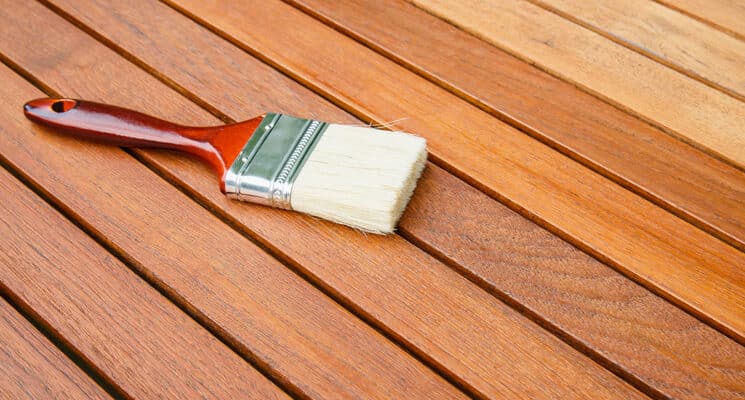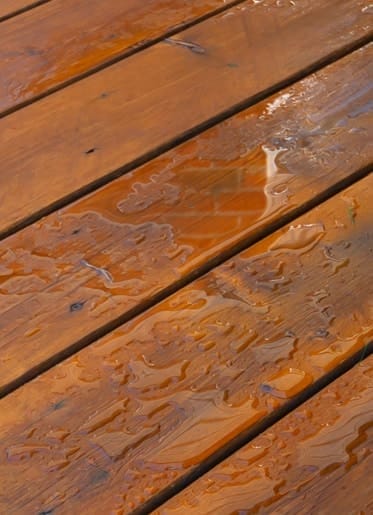
4 Deck Staining Tips: Easily Repair and Protect Your Decks.
Wood decks are a cherished addition to any home, providing a cozy outdoor space for relaxation and entertainment. However, exposure to the elements such as water, sunlight, and foot traffic can take a toll over time, leading to noticeable damage.
DIY Tips for Staining a Deck
When the signs become apparent, it’s crucial to take action to preserve and rejuvenate your deck. In this article, we’ll explore 4 tips for staining your deck effectively, ensuring its longevity and beauty for years to come.
Tip 1.
Check the Weather Before Staining
Before diving into the deck staining process, it’s essential to check the weather forecast. In the iconic words of a Bostonian, “Check the weath-ah forecast!” Deck staining should only be undertaken when there are two consecutive days of dry weather ahead.
Moisture interferes with the adherence of the stain to the wood, leading to subpar results. Additionally, avoid staining in direct sunlight, as this can cause the stain to dry too quickly, resulting in uneven coloration.

Tip 2.
Proper Surface Preparation
Preparing the deck surface is paramount for a flawless finish. Begin by clearing the area of dirt, debris, and fallen leaves. Inspect the deck for any loose nails and secure them in place using a hammer or a nail setter.
Address any peeling or splintered areas by sanding them down to create a smooth surface. For deeply discolored decks requiring extensive restoration, consider employing a wood sander for efficient results. If you’re in Massachusetts, contact H.D.F. Painting for professional assistance with your deck staining needs.
Finally, make sure the deck is thoroughly cleaned by sweeping and vacuuming to remove any remaining dirt or dust particles.
If your deck is just dirty and has mold or mildew, use a powerwasher to clean the surface. Be sure to maintain a safe distance between the powerwasher nozzle and your deck surface to avoid damaging the wood.
Tip 3.
Selecting the Right Tools For Deck Staining.
Choosing the appropriate tools is key to a productive staining process. You have three primary options for application: synthetic brushes, rollers with nap lengths of ¼ inches or shorter, or stain pads.
Cabot’s Stain Pads offer a convenient solution, especially for larger decks, as they can be attached to a pole for ease of use. However, it’s advisable to practice with these tools beforehand for optimal results.
The selection of tools should be tailored to the size and intricacy of your deck. Brushes are ideal for precision work and tight edges, while rollers or stain pads may expedite the process for larger surfaces.

Tip 4.
Don’t Rush Between Coats & Avoid Overcoating!
Patience is key when it comes to applying multiple coats of stain. Allow at least four hours between coats to ensure proper absorption and adhesion to the wood. Some products may allow for wet-on-wet application but always refer to the manufacturer’s instructions for guidance.
Avoid the common mistake of overcoating, as excessive layers of stain can lead to pooling and uneven coverage. Typically, one or two coats are sufficient to seal and protect the deck wood effectively.
By following these expert tips, you can breathe new life into your weather-worn deck, enhancing its beauty and durability for years to come. Whether you’re a seasoned DIY enthusiast or seeking professional assistance, proper staining techniques are essential for preserving the heart of your outdoor living space.
Bounce Deck Staining tip.
Selecting a Deck Stain Type
Choosing the right deck stain is crucial for achieving the desired look and long-lasting protection for your outdoor space. When it comes to deck stains, two primary options stand out: water-based stains and oil-based stains.
Water-Based Stains
Water-based stains offer several advantages, including quick drying times, easy cleanup with water, and low odor during application. They also provide excellent UV resistance and are less likely to fade over time. Additionally, water-based stains tend to be more environmentally friendly and have fewer volatile organic compounds (VOCs), making them a preferred choice for eco-conscious homeowners.
Oil-Based Stains
On the other hand, oil-based stains offer superior penetration into the wood, resulting in enhanced durability and protection against moisture, mildew, and mold. They also tend to provide a richer color and longer-lasting finish compared to water-based stains. However, oil-based stains typically have a longer drying time and require mineral spirits or other solvents for cleanup, which can be more labor-intensive.
In the end, the decision on whether to use water-based or oil-based stains relies on individual preferences, the deck’s condition, and the desired results. Take into account aspects like ease of use, longevity, eco-friendliness, and color choices when making a choice. Regardless of your selection, proper preparation of the surface and application methods are essential for achieving a stunning and durable finish for your deck.
If you are located in Massachusetts, around the Concord area, and you want to hire a professional to handle deck staining job, you can always contact us at H.D.F. Painting. We will be happy to help you with your deck staining project.
Get in touch

